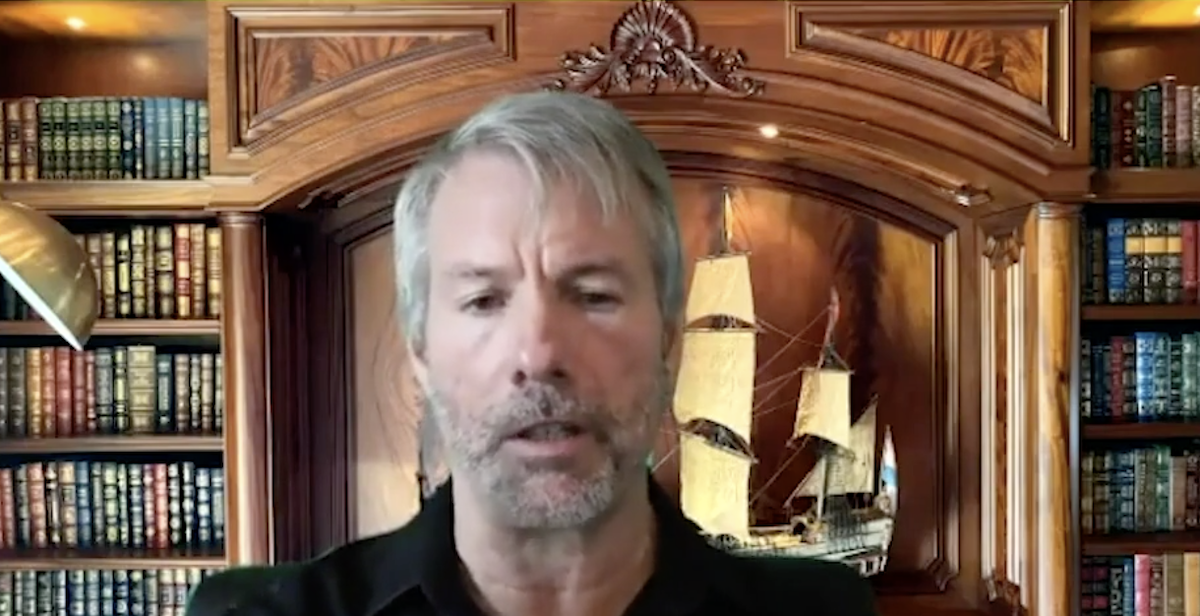MicroStrategy’s headline-grabbing bitcoin bet was a rational response to a macroeconomy in chaos, said Chief Executive Michael Saylor.
Appearing Tuesday at CryptoX’s Bitcoin for Advisors virtual conference, Saylor shed new light on one of this year’s biggest cryptocurrency stories: his software company’s recent purchases of $425 million in bitcoin.
That surprise September move by Nasdaq-listed MicroStrategy marked one of the first – and largest – embraces of bitcoin by a mainstream corporation.
In a prerecorded fireside chat with CryptoX Chief Content Officer Michael Casey, Saylor unpacked MicroStrategy’s bitcoin thought process, why it decided to eschew cash as a treasury reserve and whether gold can reclaim its spot as the marquee store of value in an increasingly digital world.
Saylor’s short answer: Gold can’t. He thinks bitcoin has seized the lead.
Hoarding gold is “an antiquated approach to storing value,” he said. Bitcoin is “a million times better.”
Printer go brr
In Saylor’s telling, MicroStrategy’s bitcoin journey began with the realization its $500 million cash pile was being eaten alive by government money printers. With recent emergency stimulus inflating the U.S. money supply faster than a Thanksgiving parade balloon, company executives felt compelled to move the treasury reserves away from the dollar.
“What we’re trying to do is preserve our treasury,” he said. “The purchasing power of the cash is debasing rapidly.”
Read more: ‘I Didn’t Buy It to Sell It. Ever.’ MicroStrategy’s Michael Saylor on His $425M Bitcoin Bet
For the last decade or so, the M2 money supply – the sum of physical cash, checking and savings accounts, certificates of deposit and money market funds – grew a modest 5.5%, Saylor noted. “A rational view of business treasury strategy would be, you had to get more than five and a half percent as your cost of capital in order to hold your purchasing power from 2011 to 2020,” he said.
But when COVID-19 hit this year, tanking the economy, the measures taken to contain the damage swelled M2 by 20%, raising the hurdles for corporate treasurers to preserve that purchasing power. “The cost of capital of every cash treasury or every treasury in the world is now 20%,” Saylor said.
To be sure, U.S. inflation, as measured by the core Consumer Price Index (which excludes food and energy) declined briefly in 2020. But to Saylor, that measure is “irrelevant.”
“If inflation only means a market basket of things with no food and energy in them, then almost by definition I’ve defined a metric which will never go up,” he said.
He pointed to cash holders in inflation-prone countries like Argentina, Brazil and Venezuela. They know all too well their purchasing power takes a hit when money supply expands.
“What if you live in Europe and the United States? It wasn’t obvious. But it needs to become obvious,” Saylor said. “I think people will figure it out.”
Bitcoin pivot
Convinced the dollar was no place for MicroStrategy’s excess capital, Saylor said he and his executives began trawling around for a “tangible” asset alternative. “We had to cycle through real estate, bonds, equity, precious metal, derivatives or crypto,” Saylor said.
Of that group, precious metals, particularly gold, has long stood as an enticing store of value, a scarce, safe-haven asset recognized around the world. Not to Saylor. For starters, he balked at the notion that gold is scarce. “Gold is the least abundant of the commodities, but you can still produce gold,” he said.
But he’s also acutely concerned with what he describes as the clashing interests of gold miners and gold bugs. One is trying to capitalize on the market by mining replenishable supply while the other is hoping that access remains scarce, pushing prices up.
“The gold miners are the enemies of the gold holders,” said Saylor. “The gold miners are trying to destroy your value, right? They’re not trying to help you.”
He predicts an even bigger problem with the gold market: Investors fleeing to bitcoin. Even if they don’t know it yet, Saylor thinks gold investors will eagerly dump the commodity for what he calls a superior store of value. It’s not an if. It’s a when.
“Not a good bet to bet against ingenuity and assume that people will be lazy and ignorant for the next decade, because it’s not likely,” Saylor said.
Debasing fiat
Citing one analyst’s prediction that Federal Reserve action will keep equities moving upward regardless of the recent election’s outcome, Saylor said the “most aggressive monetary expansion” is probably ahead.
Investors will therefore likely continue treating blue-chip juggernauts from Apple to Amazon as a new kind of safe haven. “They’re desperately grasping at straws,” Saylor said. All those assets are reliant on the fiat currency he sees as crumbling away.
“Equities don’t make a good store of value over the long term, unless the company can raise its prices faster than the rate of monetary expansion, or raise its gross margins faster than the rate of monetary expansion,” he said.
Saylor predicts monopolistic corporations will be the only ones positioned to achieve that kind of price pump. But the politicians won’t let those corporations exercise such power indefinitely, he said. So, back to square one.
“Ultimately you have to find something which you can’t print more of that doesn’t have its fundamental underpinnings tied to a fiat currency, and the only thing that I can find right now is bitcoin,” he said.




